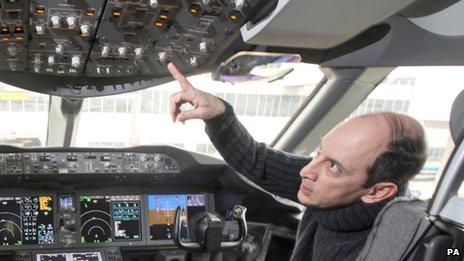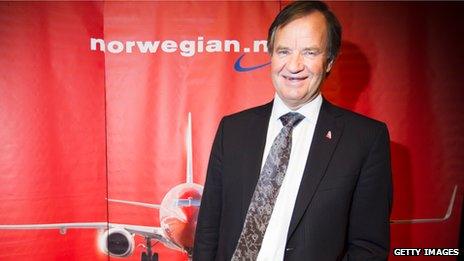Boeing 787 Dreamliner: The impact of safety concerns
- Published
Plane manufacturer Boeing and an extensive number of aerospace analysts have responded relatively calmly to a cracked cockpit window, an electrical fire possibly caused by faulty batteries, fuel leaks, and brake problems possibly caused by computer problems.
All the faults were discovered in one type of aircraft - the hyper-modern 787 Dreamliner - and the incidents, which have all occurred in a matter of weeks, have generally been treated as safety-scares by passengers and the general media.
Industry observers have responded differently, however, with many insisting they have not been surprised by what has happened.
But as the number of worrying occurrences has increased, the chorus of analysts' dismissals - which have generally described them as to-be-expected "teething problems" that are supposedly commonplace whenever an all-new aircraft goes into service - is beginning to sound hollow to many.
Suggestions that each situation has merely uncovered easy-to-fix faults, clearly raises the question why were they not both discovered and fixed before the plane went into commercial service in October 2011?
After all, deliveries of the plane to launch customer All Nippon Airways (ANA) was delayed by three years. Might it not be tempting to expect Boeing's engineers and safety inspectors to have spent their time during those years ensuring the plane was ready to enter service?
"I don't think there's any excuse for these problems any more," Qatar Airways' chief executive Akbar Al Baker told BBC News in a recent interview, ahead of many of the latest scares.
Reputations at risk
Regulators around the world are investigating. Boeing says it is co-operating with the authorities.

Qatar Airways' Akbar Al Baker says Boeing must pay compensation
Beyond that there is little to be said about that until conclusions are reached.
In the meantime, Boeing's airline customers are left hanging, counting the cost of keeping planes grounded as a result of safety concerns, or to facilitate investigations or time-consuming repairs.
The Japan authorities were the first to ground 787s owned by its airlines. Most of the other relevant authorities have followed suit meaning most of the existing global fleet of the plane is out of service for the time being.
The airlines are also acutely aware of the damage such incidences can cause their reputation, as made clear by ANA's vice-president Osamu Shinobe and executive Hiroyuki Ito's actions as they bowed in shame to apologise to passengers and their family members for causing them concern.
Indeed, in an effort apparently designed to calm concerns, one of Boeing's airline customers - Bjorn Kjos, chief executive of Norwegian Air Shuttle - has come out in defence of the plane, echoing the view that "minor problems" such as these should be expected.
Norwegian has yet to take delivery of the Dreamliner, though the aircraft is vital to its ambitious plan to expand by offering long-haul flights. Japan's two main airlines ANA and JAL also have long-haul plans for their fleet of Dreamliners, which were destined to operate on European and American routes.
Qatar's Mr Baker has long questioned whether the recurring faults are merely "teething problems" and has voiced concerns about how the Dreamliner's delays, and now its faults, have made it difficult for successful airlines to plan ahead and to expand as quickly as they would like to.

ANA executives bowed in shame to apologise to passengers and their families
Mr Baker has already said he would expect Boeing to pay compensation for its failure to deliver usable planes.
"They will have to if they deliver aeroplanes that can't fly," he said in the recent interview. "We are not buying aircraft to put in museums, we're buying them to fly."
It seems inevitable that there are armies of lawyers out there getting ready for similar discussions with Boeing on behalf other airlines customers.
But damage claims from airlines may not be the aerospace giant's biggest headache right now.
Worst-case scenario
A greater concern is probably the impact the latest scares might have on its own order book, which currently contains some 800 Dreamliners scheduled for production and delivery over the next decade.
A worst-case scenario would be one where airlines started backing away from their orders, though given that no-one currently makes a similar aircraft they are unlikely to do so - not least since there are no guarantees a forthcoming rival plane, the A350 from Airbus, will be introduced without problems of its own.
Another painful scenario would result from regulators discovering serious problems that would require time-consuming work that could delay future deliveries, perhaps resulting in demands for compensation payments or discounts on a vast scale.

Norwegian Air Shuttle chief executive Bjorn Kjos says he is not concerned
That would not only threaten Boeing's break-even target of 1,100 Dreamliner deliveries over the next decade, but also sour its relations with airline customers at a time when there is much talk of the emergence of new rival aircraft manufacturers in Russia and China.
Against such scenarios, the best outcome for everyone - whether planemakers, airlines or end-customers - is one where faults are quickly identified, resulting in repairs being carried out within months.
And whatever the investigations throw up, everyone concerned are eager to stress that although cost concerns are deemed important, the only thing that really matters is that flights are safe.
- Published16 January 2013
- Published16 January 2013
- Published24 April 2012
- Published15 January 2013
- Published8 January 2013
- Published13 December 2012